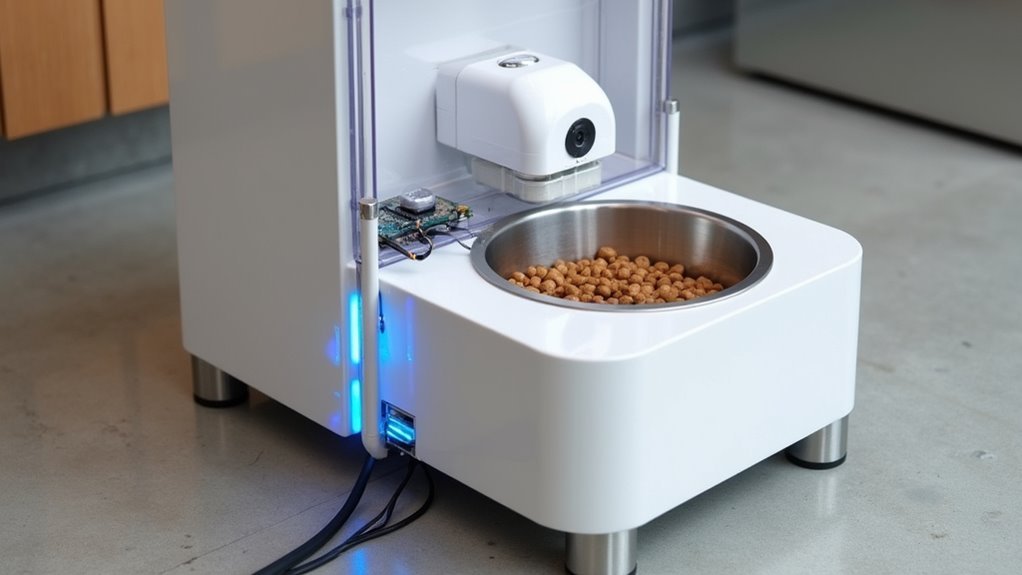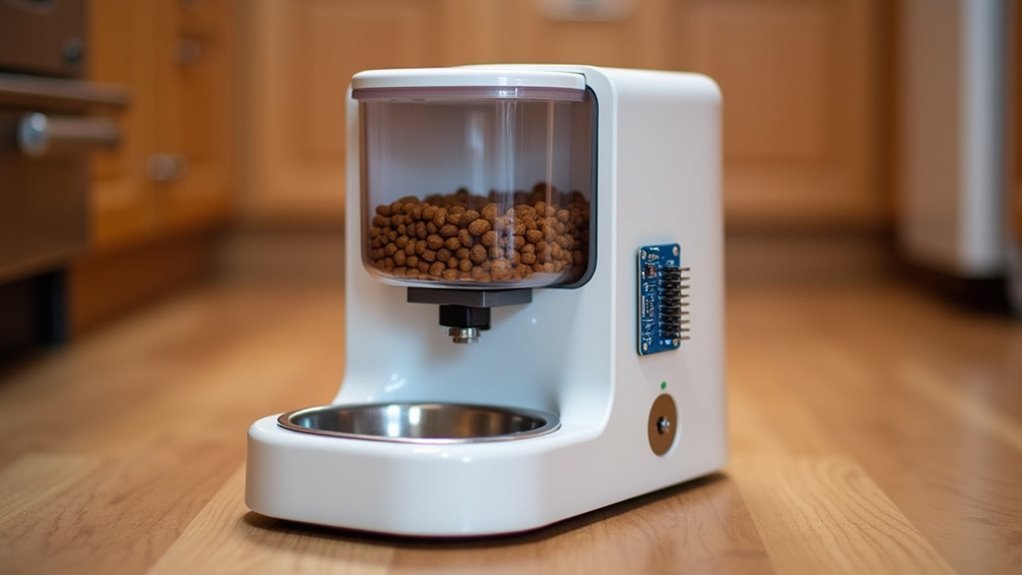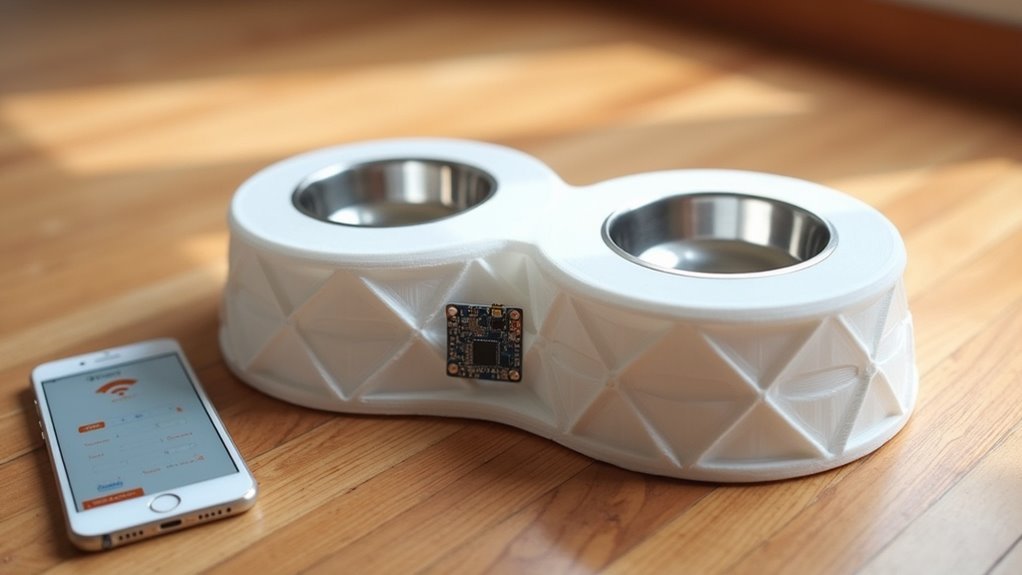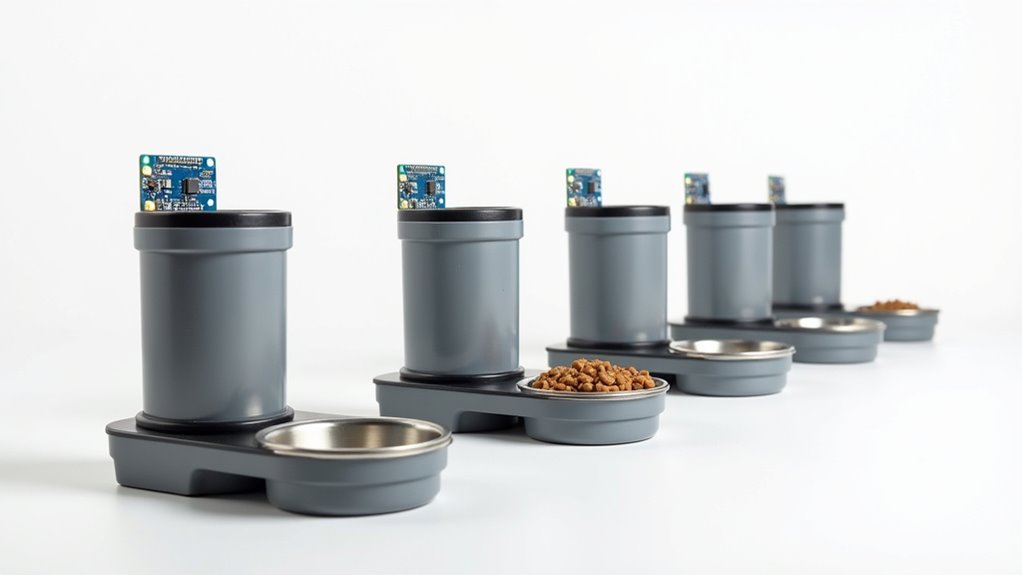You’ve probably considered automating your pet’s feeding schedule, but choosing the right ESP8266-based system can feel overwhelming with so many DIY options available. Whether you’re dealing with irregular work hours or simply want consistent portion control, these seven automated feeding stations offer everything from smartphone integration to voice commands. The key isn’t just finding a feeder that works—it’s discovering which features will actually transform your daily routine.
Blynk-Controlled Pet Feeder With Video Monitoring Capabilities

When you’re looking for complete control over your pet’s feeding routine, the Blynk-controlled pet feeder with video monitoring delivers extensive remote management through your smartphone.
This ESP8266-powered system lets you control feeding schedules and portion sizes from anywhere with WiFi access.
The Blynk-controlled pet feeder features a stepper motor that replaces manual cereal dispenser controls, ensuring precise food measurements.
You’ll receive real-time updates on feeding counts and last feeding times through the app while calibrating feeder flaps for ideal performance.
Video monitoring uses repurposed old mobile phones as streaming servers, providing live feeds to verify your pet’s safety and feeding accuracy.
You’ll need proper port forwarding configuration for seamless external video access, but this setup creates thorough remote pet care management.
Home Assistant Compatible Smart Pet Feeder With Custom Firmware
If you’re already running a Home Assistant smart home setup, this ESP8266-powered pet feeder integrates seamlessly into your existing ecosystem through custom firmware and MQTT protocols.
You’ll develop the firmware using Arduino IDE, connecting your feeder using WiFi and configuring feeding schedules through an intuitive web interface.
The stepper motor delivers precise food dispensing with consistent portion control, eliminating wastage while ensuring your pet receives accurate meal sizes.
You can reset settings and adjust parameters by pressing specific button combinations, making device management straightforward.
MQTT support enables communication with other smart devices, letting you create automated feeding routines.
You’ll control everything remotely through Home Assistant’s interface, scheduling meals and monitoring feeding status from anywhere while maintaining complete integration with your smart home automation.
Nodemcu-Based Automated Dog Feeder With Multi-Platform Integration

You’ll find the NodeMCU’s ESP8266 chip provides exceptional versatility for building a smart dog feeder that connects across multiple platforms and devices.
The hardware setup requires just a few key components including the NodeMCU board, a continuous rotation servo for food dispensing, and basic wiring connections that you can complete in minutes.
Your feeder’s built-in web server responds to simple GET requests, enabling control through Amazon Dash buttons, OpenHAB home automation, Android’s Tasker app, or even wearable devices like the Pebble Watch.
Hardware Components Setup
Building your NodeMCU-based automated dog feeder starts with understanding the ESP8266’s core capabilities as your project’s brain. You’ll leverage its 10 GPIO pins and USB power connection for this low-cost automatic pet feeder solution.
| Component | Function | Connection |
|---|---|---|
| NodeMCU ESP8266 | Main controller | USB power supply |
| Parallax Continuous Servo | Food dispensing mechanism | GPIO pin assignment |
| Wi-Fi Module | Remote connectivity | Built-in ESP8266 feature |
| Power Supply | System operation | USB connection |
Your servo motor handles the physical food dispensing through HTTP GET requests via the mini web server. You’ll need to configure Wi-Fi credentials and verify IP addresses during setup. The initial firmware flash establishes proper servo communication, ensuring your automatic pet feeder responds reliably to remote commands from multiple platforms.
Multi-Platform Control Options
Once your NodeMCU establishes Wi-Fi connectivity, you can control your automated dog feeder through multiple platforms that leverage the ESP8266’s built-in web server capabilities.
You’ll access multi-platform control options including HTTP GET requests from mobile devices, smartwatches, or web browsers. The NodeMCU hosts applications directly, eliminating external server dependencies.
You can integrate Amazon Dash Button for one-touch feeding, configure OpenHab for smart home automation, or use Tasker on Android to trigger feeding based on custom schedules.
Voice command functionality becomes possible through Amazon Alexa or Google Home via Senric Pro integration.
These platforms work simultaneously, providing redundant control methods. Whether you’re using smartphone apps, voice commands, or automated triggers, the NodeMCU’s affordable $4-$6 price point makes experimenting with different control methods cost-effective for your DIY pet feeding project.
Web Server Configuration
The foundation of your NodeMCU-based automated dog feeder relies on configuring a robust web server that transforms the ESP8266 into a standalone feeding control hub.
Your web server configuration begins by connecting the NodeMCU via USB and flashing the appropriate firmware. You’ll need to establish Wi-Fi credentials using Esplorer to guarantee seamless network connectivity.
The core configuration involves creating an `init.lua` file that handles incoming GET requests for servo activation. This file works alongside a separate `servo.lua` file that directly controls the motor’s dispensing mechanism.
Once you’ve uploaded both files, the ESP8266 creates a mini web server accessible through your network. You can test functionality immediately through the web interface, providing real-time control and management capabilities for your pet’s feeding schedule.
Wifi-Enabled Pet Feeder With 3D Printed Design Components

You’ll find that 3D printed components offer exceptional customization flexibility, allowing you to tailor the feeder’s size and shape to fit perfectly in your specific kitchen space while maintaining durability.
The ESP8266 microcontroller enables seamless WiFi control through mobile apps, letting you manage feeding schedules remotely and receive real-time updates on your pet’s meals.
This combination of customizable hardware and wireless connectivity creates a feeding solution that’s both highly functional and perfectly suited to your home environment.
3D Printing Design Benefits
Innovation in 3D printing technology transforms how you can design and build ESP8266-powered pet feeding stations.
You’ll achieve complete customization flexibility, creating tailored components that perfectly fit your specific pet food types and dispensing mechanisms. This approach considerably cuts manufacturing costs and production time, making unique parts like custom hoppers and bowls economically viable.
You can seamlessly integrate these lightweight 3D printed components with your ESP8266’s Wi-Fi capabilities, enabling remote control and monitoring through mobile apps.
The iterative design process becomes effortless—you’ll easily modify and refine parts based on real-world performance feedback.
Most importantly, the reduced weight of 3D printing components minimizes motor strain, greatly extending your automated feeding system’s operational lifespan while maintaining ideal efficiency.
WiFi Control Implementation
When you implement WiFi control in your ESP8266 pet feeder, the NodeMCU board becomes the communication hub that connects your 3D printed feeding station to your smartphone and smart home ecosystem.
You’ll use custom Arduino code with WiFiManager to establish seamless connections to your local WiFi network, eliminating complicated setup procedures.
The integrated mini web server responds to GET requests, giving you flexible control options through the Blynk app for scheduling and portion adjustments.
You can activate feeding sessions remotely, integrate with Home Assistant, or even connect Amazon Dash buttons for instant dispensing.
Since you’re using NodeMCU, you won’t need additional FTDI adapters, streamlining your build process.
This WiFi implementation transforms your 3D printed feeder into a smart device that fits perfectly within modern connected home environments.
Stepper Motor Precision Pet Feeding Station With Mobile App Control
Precision meets convenience in this stepper motor-powered feeding station that transforms an ordinary cereal dispenser into a smart pet feeding solution.
You’ll achieve exceptional accuracy with the short geared NEMA 17 stepper motor featuring a 26.85:1 gear ratio and 0.067° step angle resolution. This configuration delivers high torque while ensuring consistent portion control for your cats or Koi Carp.
The ESP8266 module enables seamless WiFi connectivity, letting you control feeding schedules and portion sizes through the Blynk mobile app from anywhere.
You can monitor your pets’ feeding remotely with real-time updates and adjustments.
The waterproof cabinet design makes this system perfect for outdoor installations, while the integrated LM2596 DC converter safely regulates 12V power down to 5V for reliable electronic component operation.
Voice-Activated Pet Feeder With Amazon Dash Button Support
Building on the foundation of automated precision, this voice-activated pet feeder elevates convenience by integrating Amazon Alexa and Google Home compatibility with your ESP8266-powered feeding system.
Transform your pet feeding routine with seamless voice control through Alexa and Google Home integration on your ESP8266 system.
You’ll enjoy hands-free control through simple voice commands, eliminating the need to manually operate your feeder.
The NodeMCU controls your feeding mechanism while supporting Amazon Dash Button functionality for remote triggering.
You can customize feeding schedules and portion sizes through either the web interface or voice commands, creating tailored solutions for your pet’s needs.
Your feeder’s mini web server responds to GET requests, ensuring compatibility with smart home platforms like openHAB and Tasker.
This seamless integration lets you schedule feeding intervals or activate on-demand dispensing, giving you complete flexibility in managing your pet’s nutrition remotely.
Modular ESP8266 Pet Feeding System With Customizable Portion Control
Three distinct advantages set this modular ESP8266 pet feeding system apart: customizable portion control, versatile food compatibility, and seamless smartphone integration.
You’ll control feeding schedules and portion sizes remotely using the intuitive Blynk app, ensuring your pets receive ideal nutrition whether you’re home or away.
The system employs a short geared NEMA 17 stepper motor with a 26.85:1 gear ratio, delivering precise dispensing of dry food pellets.
You can manually feed your pet using one built-in switch for immediate access, while the app automatically tracks feeding counts and times for thorough care management.
This versatile feeder accommodates various food types, making it perfect for cats and Koi Carp alike.
The waterproof cabinet option enables reliable outdoor use, expanding your feeding possibilities beyond indoor environments.
Frequently Asked Questions
Which Automatic Pet Feeder Is Best?
You’ll find the Tuya Smart Automatic Pet Feeder offers excellent value at €40, providing ESP8266 integration, mobile app control, portion scheduling, and smart home compatibility with Alexa or Google Home for convenient feeding.
What Is the Best Wirecutter Automatic Pet Feeder?
You’ll find Wirecutter’s top automatic pet feeder is the PetSafe Smart Feed. It’s priced around $130, offers Wi-Fi connectivity, smartphone control, customizable scheduling, portion control, and includes a built-in monitoring camera.
Do Vets Recommend Automatic Feeders?
You’ll find that many vets recommend automatic feeders for portion control and scheduled feeding, especially for weight management. However, they don’t suggest them for anxious pets needing human interaction during meals.
What Are the Disadvantages of Automatic Feeders?
You’ll face overfeeding risks from improper calibration, potential electronic malfunctions disrupting meals, inconsistent food dispensing with certain kibble types, reduced pet interaction affecting psychological well-being, and high upfront costs exceeding €250.





Leave a Reply